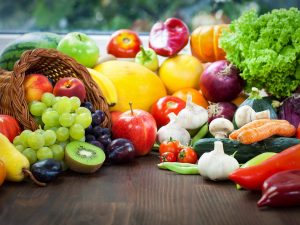Then the Land will yield its fruit and you will eat your fill and live there in safety. Leviticus 25
Widespread adoption of a meat free diet could see greenhouse gas emissions drop by 63 per cent. You can also reduce your environmental footprint by eating food produced according to LOAF principles:
Local – so fewer food miles
Organic – fewer chemicals which helps to conserve biodiversity
Animal-friendly – if you choose to eat meat, buy meat with a higher welfare standard
Fair-trade – better prices, decent working conditions, local sustainability, and fair terms of trade for farmers and workers in the developing world.
- Plant a fruit tree or some vegetables
- Check your shopping for sustainable palm oil. According to WWF, palm oil is a very efficient crop and it is better to buy responsibly-produced palm oil than to boycott it altogether.
- Reduce your meat consumption. You could increase the vegetable content of meat dishes as well as eating vegetarian or vegan food.
- Set up a compost bin
- Swap one item in your shopping basket for local, organic or fair-trade food
- Plan your meals and use a shopping list. You could use an app like Kitche to keep track of food.
- Eat seasonally – there are lots of ideas online, for example the BBC website
- Instead of throwing away leftover food, see if you can use it to make something else (see lovefoodhatewaste.com for some ideas)
- Buy loose fruit and vegetables when possible. You can buy the amount you need and reuse a plastic bag, both of which save waste.
- Use your food waste bin and help to generate green energy. Recycling just 6 tea bags creates enough energy to boil the kettle for another cup of tea. One banana peel could charge your phone twice.

